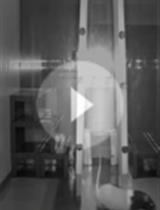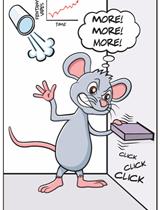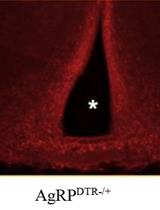- EN - English
- CN - 中文
Touchscreen-based Visual Discrimination and Reversal Tasks for Mice to Test Cognitive Flexibility
采用基于触摸屏的小鼠视觉辨别和颠倒任务测试认知灵活性
发布: 2017年10月20日第7卷第20期 DOI: 10.21769/BioProtoc.2583 浏览次数: 10487
评审: Soyun KimAlexandra GrosAnonymous reviewer(s)
Abstract
Reversal learning can be used to examine deficits in cognitive flexibility, which have been linked to a number of neuropsychiatric disorders including schizophrenia and addiction. However, methods of examining reversal learning have varied substantially between species. Touchscreen technology has allowed researchers to explore cognitive deficits with a platform that is translatable across rodents, non-human primates and human subjects. Here we describe a method for measuring visual discrimination and reversal learning in mice using automated touchscreen-based operant chambers.
Keywords: Visual discrimination (视觉辨别)Background
Cognitive flexibility is the ability to flexibly adjust responses to a previously learned stimulus-reward association, and impairments occur in a range of neuropsychiatric conditions, including schizophrenia, autism, obsessive-compulsive disorder and addiction. To further study the neural mechanisms implicated in cognitive flexibility, performance of choice and reversal tasks have been used in animal models. There are a variety of methods used to measure cognitive flexibility in rodent models, however many techniques have been difficult to compare between rodent and human studies (Brigman et al., 2010). However, using touchscreens, a similar paradigm can be used to study reversal learning across species (Bussey et al., 2012; Horner et al., 2013). Trained rodents are able to discriminate visual stimuli and then successfully reverse their choice when the contingency changes. However, cognitive performance in both rats and mice has been shown to be highly strain dependent (Graybeal et al., 2014). C57BL/6J mice are a popular strain for behavioural and genetic studies, and have been used as a standard strain against which others are compared (Izquierdo et al., 2006). Meanwhile, BALB/c mice often display poor learning and cognitive performance compared to other strains (Graybeal et al., 2014). Recently, the BALB/c strain was shown to be ‘severely impaired’ in basic training, visual discrimination and reversal learning using touchscreen chambers (Graybeal et al., 2014). Therefore, we have adapted the training protocol to promote responding in an anxious mouse strain (BALB/c), where behavioural (rather than cognitive) traits may impair performance. Our results indicated that this protocol provides comparable levels of performance in the standard C57BL/6 mouse to those previously published and significantly enhanced performance of the anxious and emotionally reactive BALB/c mouse (Turner et al., 2017).
Materials and Reagents
- Small containers, such as 50 ml Falcon tube lids (BD Biosciences)
- Paper towels for cleaning chambers
- Our experiment used male BALB/c or C57BL/6J mice (Animal Resource Centre, Australia) at 12 weeks of age one week after arrival to allow the mice to habituate to the facility
Notes:- Mice are housed in groups of four in individually ventilated cages (OptiMICE, Animal Care Systems, USA) with water available ad libitum. Mice are housed with bedding with tissues. The temperature (21 ± 1 °C) and humidity (50 ± 10%) are controlled and lights are kept on a 12-h cycle (lights on at 07:00 AM).
- Mice are tail marked for identification and weighed for 3 days to get an average free-feeding body weight. Food restriction should be conducted for at least 3 days prior to testing to gradually reduce weight and allow mice to adapt to a set feeding schedule. Food restriction is used as mice will readily perform for strawberry milk rewards when hungry.
- They are then food restricted to around 90% of their free-feeding body weight using small pieces of food to minimise fighting.
Ensure that growth relevant to the strain and age is considered in determining ongoing food restriction limits. - Treatment group size should be based on a power analysis where possible, however groups of 10-15 mice are commonly considered sufficient.
- Mice are housed in groups of four in individually ventilated cages (OptiMICE, Animal Care Systems, USA) with water available ad libitum. Mice are housed with bedding with tissues. The temperature (21 ± 1 °C) and humidity (50 ± 10%) are controlled and lights are kept on a 12-h cycle (lights on at 07:00 AM).
- Undiluted strawberry milk (Breaka, Parmalat, Australia)
- Ethanol (70%) for cleaning chambers
Equipment
- Bussey-Saksida Mouse Touchscreen Chambers (Campden Instruments, model: Model 80614 ) equipped with:
- Touchscreen
- House light
- Liquid reward dispenser
- Magazine
- Two-window black masks
- Overhead camera
- Sound-attenuating chamber
- Multi-Media Single Station Licence for each chamber (Campden Instruments, model: Model 80698-1 )
- Touchscreen
Software
- PC with ABET II Software for Touchscreens (Model 89505, Campden Instruments Ltd., UK) with Whisker Multi-Media Single Station Licence for each chamber (Model 80698-1, Campden Instruments Ltd., UK)
- SPSS (ver.20, SPSS Inc., Chicago, USA)
Procedure
文章信息
版权信息
© 2017 The Authors; exclusive licensee Bio-protocol LLC.
如何引用
Turner, K. M., Simpson, C. and Burne, T. H. J. (2017). Touchscreen-based Visual Discrimination and Reversal Tasks for Mice to Test Cognitive Flexibility. Bio-protocol 7(20): e2583. DOI: 10.21769/BioProtoc.2583.
分类
神经科学 > 行为神经科学 > 认知
神经科学 > 行为神经科学 > 实验动物模型 > 小鼠
您对这篇实验方法有问题吗?
在此处发布您的问题,我们将邀请本文作者来回答。同时,我们会将您的问题发布到Bio-protocol Exchange,以便寻求社区成员的帮助。
Share
Bluesky
X
Copy link












